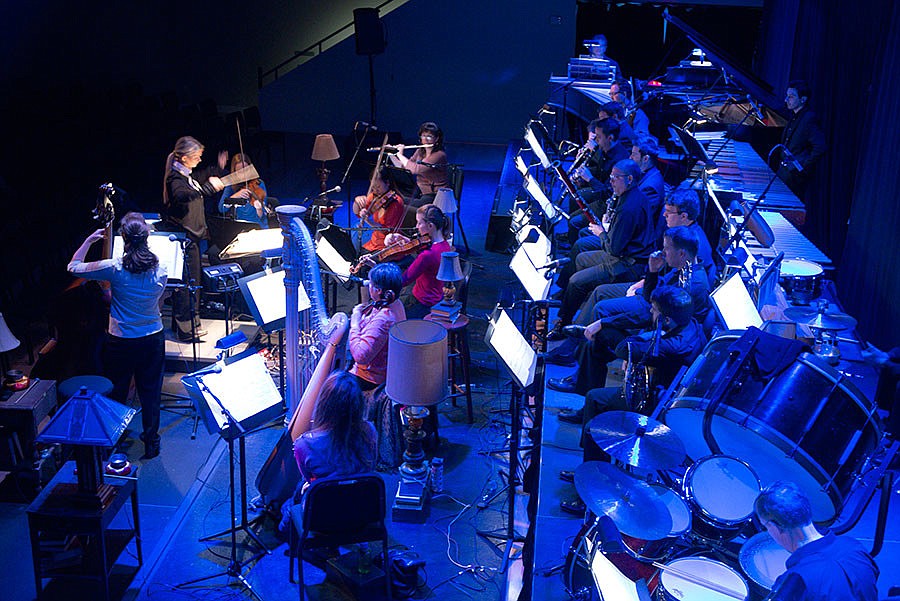- April 25, 2024
-
-
Loading

Loading

Music is, without question, an aural experience. But some music is aurally sonic, like a boom that explodes in your head and leaves an indelible impression on your brain. Heiner Goebbels, a composer who works with sounds as if they’re living creatures, created a work called “Songs of Wars I Have Seen.” Based on one of Gertrude Stein’s books, Goebbels has taken the rhythm and cadence of Stein’s written words and turned them into a visual, visceral experience that seems to grow on you even after the last sounds have ceased ringing from the stage.
“Songs of Wars I Have Seen” is a thought-provoking piece filled with unearthly, enigmatic sounds that, somehow, tie together the vignettes of wartime Stein wrote about. In the 1970s, the work might have been called an “encounter,” but today, especially the way Goebbels has put it together, it’s a piece of theater with music.
Set on the smallish platform of Holley Hall, the orchestra, featuring members of the Sarasota Orchestra, is placed by gender, with the men — in black attire — sitting on risers upstage, facing the audience, and the women, dressed as if at home — in differently colored tops over casual pants — are assembled as a septet, downstage, surrounded by mismatched end tables with equally off-balance lamps, as if accumulated from various homes and put together for warmth.
It’s the women, the ones at home while their men are at war, who tell their stories, and, like the prodigious author she was, Stein leaves room within her own memories for some of ours to tiptoe in and make interpretations that open windows into our souls.
Goebbels' music is at once enlightening and dramatic, but, for the most part, it’s supportive, and one has to wonder what this particular piece would be without the text. Baroque music, which the women play with eerie, supernatural, ghostlike and sometimes creepy sounds (played on a synthesizer by Joseph Holt), is the glue that connects the stories and the original music by Goebbels.
The seven women from the Sarasota Orchestra — violinists Jennifer Best Takeda and Chung-Yon Hong, violist Elizabeth Beilman, cellist Cheeko Matsusaka, bassist RoseAnne McCabe, flutist Betsy Hudson Traba and harpist Cheryl Losey — put aside their musical instruments to read the Stein stories, and they did it in a way that allowed the words to become part of the music. Although Takeda did have a sung part that was perfectly on pitch and considerably more spine-chilling and paranormal than a real singer would have pulled off, the other readings weren’t sung; they weren’t even written in rhythms or like Sprechstimme (speaking on pitch). Rather, every one of these instrumentalists’ readings followed the cadence and rhythm written into the text by Stein, making their stories natural, real and, at times, quite disturbing. Some of them were also amusing and touching. Most of all, they left room for our imaginations to see ourselves in the stories and, with Goebbels’ music underscoring the text, they were just that much more personal.
The percussion section of the orchestra had a whirlwind-of-a-time playing instruments we’d never seen before, along with familiar ones in unsettling ways. The “Sound Design,” (by Ian Dearden), something one doesn’t often connect with a so-called classical concert, brought out lines and musical motifs so we were aware of their context more than we’d have been without the amplification.
The lighting, by Michael Pasquini and the composer, who designed the lighting, was both unsettling and beautiful. Changing from the warm glow of gold one sees through the windows of a cozy cottage to bright, stark white, the lights combined with the music and text to create an ambience closer to a theatrical event than a concert setting.
Anu Tali, the Sarasota Orchestra’s music director, held all of this together in a way we’ve rarely seen in orchestral performances. Often, her role was simply beating time, a necessity when so many things were happening at once. At other times, she drew emotions from the individual instruments and sections of the orchestra. And, as in the final section, when trumpeter Michael Dobrinski performed a poignant, affecting solo, her black-clad body with long blond hair streaming down her back, was so stock still, she became part of the music, like the stark ghost light that hovered over the stage, reminding us that theaters, like people, can sometimes be heartless and empty.
That image, along with the unsettling but consoling sounds of all the musicians playing tuned Tibetan bowls, which first sounded disconcertedly like dangerous mythological Sirens but then transformed into church bells ringing out peace, brought a reassuring and comforting conclusion to this most unusual work.